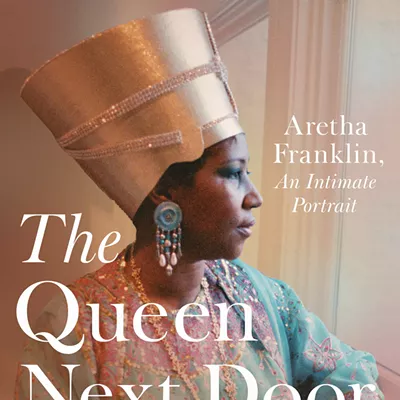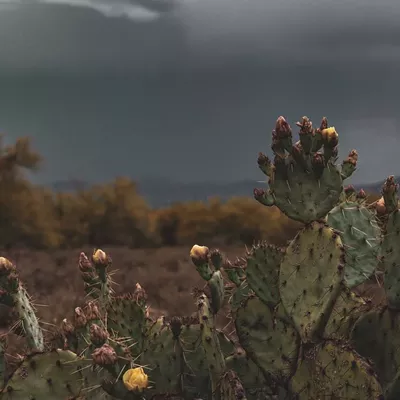"I love the desert and nature," she told a standing-room-only crowd at the Hotel Congress last week. Her enthusiastic audience of 50 were all going on the last ArtWalk of the season, and their first stop was her show of manipulated photographs in the hotel lobby, a gallery managed by Elizabeth Cherry Contemporary Art.
Salonia's exhibition, UNI/VERSI, pictures figures in the Southwestern landscape, from the desolate flats of the Willcox Playa to the beach at the troubled Sea of Cortez.
The disquiet in the photographs is deliberate.
"I'm dealing with the human in the environment in these works, and the ways we deal with the environment," said the artist. A 2000 graduate of the UA with a BFA in photography, she's also a prime mover behind the photographic collective Flashflood, which is exhibiting concurrently at the Tucson/Pima Arts Council.
Like all photographers, Salonia is guilty of the sin of using film, chemicals and other agents that pollute the earth. Sometime in the last year, she said, "I came to realize I was working in a philosophical contradiction--photography is a toxic medium."
She has heavily manipulated the new pictures, all gelatin silver prints, to emphasize what she calls the "personal contradiction" between her beloved nature and her art. Her suffering landscapes, most of them peopled by a lonely human figure, are all doused with deadly looking chemicals. Salonia pours shellacs and varnishes on the prints, here bleaching out their darks, there toning them an unhealthy-looking blue. And if the chemistry-set potions were not already enough to poison her prints, she violently scratches their surfaces.
In "Datsun, Willcox Playa," 2000, a single automobile sits incongruously in the cracked landscape, low-slung mountains fading in the distance under a big sky. The car all by itself is a sign of human encroachment in the wilderness, but Salonia has pushed its symbolism by dripping a brown liquid all over the picture. The artist puts herself by the sea, squinting into the light, in "Rosanna, Sea of Cortez," 2000. The body of water behind her--its species in danger, its fresh-water Colorado River sources being drained off to serve development--is colored that dangerous-looking blue. A sickly amber-rust glow is in the air.
But there's something else afoot--or to hand--besides the pairing of environmental destruction and photographic pollution. Salonia may be engaging in self-criticism in these interesting works but she's also defying some photographic rules. Gone is the venerated print--after slashing and burning her works she mounts them on curling cardboard--and the impersonal high-tech print is banished. All of these one-of-a-kind pieces have been touched by the human hand. Her handiwork is too wild to be called craft, but it's still a defiant bit of individualism.
Over at T/PAC, the freethinking Salonia is part of a seven-person group show on the theme of Red, wherein she demonstrates her mastery of the classic pristine print. "Red I, II and III" are small, outdoor shots in gorgeous full color, disciplined and orderly. Dappled ferns of the greenest green sway against a dark background, their fronds by turns precisely rendered and blurred out. Continuing the classical theme of the figure in the landscape, more benign here than over at the hotel, Salonia plants a naked woman amid the greenery. The body, shot from the waist down, is an immediate visual pun. Her pubic hair is red. And Salonia can't resist one more rebellious touch. She's wielded a screaming pink-red marker in the margins of these dainty prints.
Her fellow Flashflooders are current and former students in the UA photo program, all of them commendably adventurous in their forays into the medium. They've mostly adhered to the theme of human flesh, if they haven't always stuck with red. Jonathan Crumpler's Video Games, a jumpy short set to jazzy music, is full of people with very red faces and very red tomatoes. Some of the others, perhaps thinking of the old joke about black and white and red all over, define the color loosely--dropping it altogether while sticking with black and white.
Lynn Turner is one of these, showing a couple of moody black-and-white gelatin silver prints, collectively titled "The Unspeakable, The Unknowable, and Me." A grainy female figure blends into darkness; grasping her knees, her head bent down, she's the picture of despair. Another is a close-up of a woman's face, distorted--an unknowable--by scary makeup. Jessi Atwood, another black-and-whiter, has made nightmarish images of the human face altered by cosmetics. One double exposure has given a figure double eyes.
Jennifer Etsitty tries the old trick of photographing a woman looking into a mirror. But she's got something new to add to the genre, compressing her images into matchstick size and rendering them in dreamy yellow and red. Kari Alter also uses yellow--and orange--in voyeuristic works that would be manna to a Peeping Tom. All three pictures in the movie-like "Drömmen Atti Vara (The Dream to Be)" feature a large, old-fashioned widow frame, printed on black nothingness. A shadowy female figure tarries just inside the brightly lit window, seductively peeking out from behind the gauzy curtain, or waving a single hand. Finally she emerges in full view, the voyeur's reward, scantily dressed in festishistic undies.
Diana Berntzen aims a critical eye not only at tasteless American "food products" but at the soulless convenience stores that sell them. Never has the local Circle K looked so creepy as in her "American Foodstuffs," a 1999 color print. This hallucinogenic vision in sickly green pictures the hot dogs rolling on their grill and the cardboard bags of snacks glowing ominously in the aisle beyond. It's a beautiful, complex picture of something so mundane we hardly notice it in real life. But Berntzen has a barb to shoot at the selling of sex as well: The store's companion shot is of a woman bent over and raunchily displaying her hindquarters.
"Hot," Benzten has written in green letters on the store shot, "dog" in yellow on the woman's pic. Green objects glisten all around her, indecipherable but ominous, as bilious as those toxic colors on Salonia's beach.














